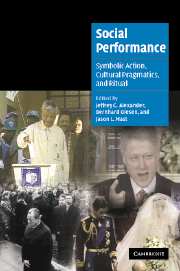Book contents
- Frontmatter
- Contents
- List of figures
- List of tables
- List of contributors
- Introduction: symbolic action in theory and practice: the cultural pragmatics of symbolic action
- 1 Cultural pragmatics: social performance between ritual and strategy
- 2 From the depths of despair: performance, counterperformance, and “September 11”
- 3 The cultural pragmatics of event-ness: the Clinton / Lewinsky affair
- 4 Social dramas, shipwrecks, and cockfights: conflict and complicity in social performance
- 5 Performing a “new” nation: the role of the TRC in South Africa
- 6 Performing opposition or, how social movements move
- 7 Politics as theatre: an alternative view of the rationalities of power
- 8 Symbols in action: Willy Brandt's kneefall at the Warsaw Memorial
- 9 The promise of performance and the problem of order
- 10 Performance art
- 11 Performing the sacred: a Durkheimian perspective on the performative turn in the social sciences
- Index
- Cambridge Cultural Social Studies
- References
11 - Performing the sacred: a Durkheimian perspective on the performative turn in the social sciences
Published online by Cambridge University Press: 07 December 2009
- Frontmatter
- Contents
- List of figures
- List of tables
- List of contributors
- Introduction: symbolic action in theory and practice: the cultural pragmatics of symbolic action
- 1 Cultural pragmatics: social performance between ritual and strategy
- 2 From the depths of despair: performance, counterperformance, and “September 11”
- 3 The cultural pragmatics of event-ness: the Clinton / Lewinsky affair
- 4 Social dramas, shipwrecks, and cockfights: conflict and complicity in social performance
- 5 Performing a “new” nation: the role of the TRC in South Africa
- 6 Performing opposition or, how social movements move
- 7 Politics as theatre: an alternative view of the rationalities of power
- 8 Symbols in action: Willy Brandt's kneefall at the Warsaw Memorial
- 9 The promise of performance and the problem of order
- 10 Performance art
- 11 Performing the sacred: a Durkheimian perspective on the performative turn in the social sciences
- Index
- Cambridge Cultural Social Studies
- References
Summary
Introduction
Although generating a logic and scholarly sophistication of its own, social theory has always gained additional power and plausibility when grounded in pre-scientific paradigms and commonsense images of social reality. In this way the classical social theory of the eighteenth century started with the idea of society as a normative constitution based on contract; later on it imagined society as a coercive organization, as an organized division of labor or as a market. During the so-called cultural turn of the 1980s, social reality was conceived as a text that is interpreted by other texts. Meanwhile the focus has shifted from the structure of the text to the process of narrating it, from the normative constitution to the rituals of contracting, from the coercive organization and the revolutionary movement to the rituals of staging authority and the rituals of rebellion: social theory is going to take a performative turn.
Of course, this turn to performance is not entirely new. It has been preluded by the debate about the primacy of ritual over myth in classical anthropology (Smith 1927; Frazer 1922), it borrows from the theory of drama (Burke 1965; Schechner 1976), from the theory of speech acts (Searle 1970; Austin 1975), from the ethnomethodological thrust to dissolve institutional structures into modes of practices (Garfinkel 1989), and, most important of all, it has been programmatically introduced, some decades ago, by Victor Turner (Turner 1969, 1974, 1982) and Erving Goffman into sociology (Goffman 1959, 1986).
- Type
- Chapter
- Information
- Social PerformanceSymbolic Action, Cultural Pragmatics, and Ritual, pp. 325 - 367Publisher: Cambridge University PressPrint publication year: 2006
References
- 28
- Cited by



